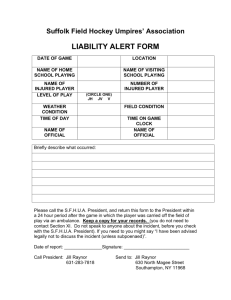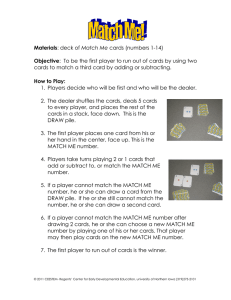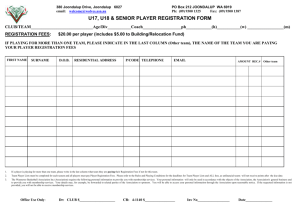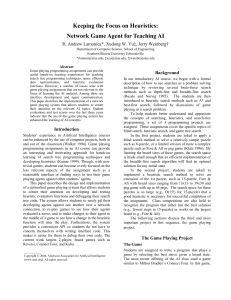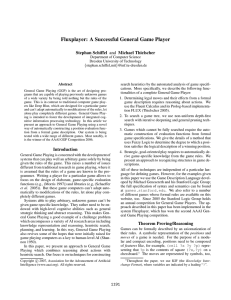Automatic Heuristic Construction for General Game Playing
advertisement
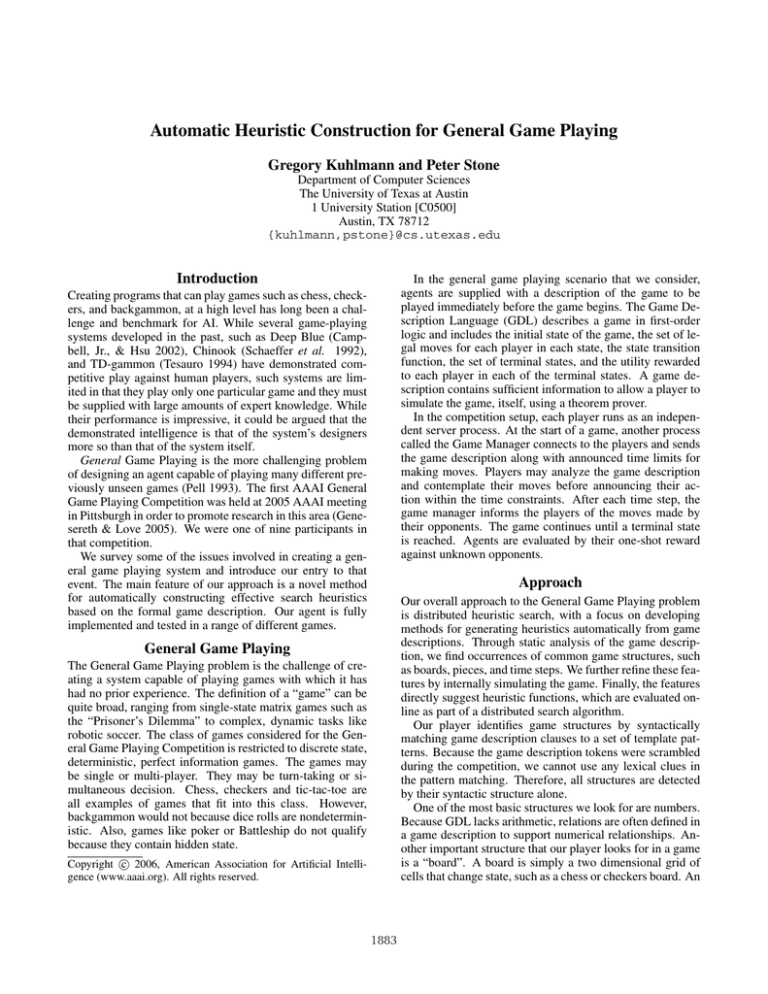
Automatic Heuristic Construction for General Game Playing
Gregory Kuhlmann and Peter Stone
Department of Computer Sciences
The University of Texas at Austin
1 University Station [C0500]
Austin, TX 78712
{kuhlmann,pstone}@cs.utexas.edu
Introduction
In the general game playing scenario that we consider,
agents are supplied with a description of the game to be
played immediately before the game begins. The Game Description Language (GDL) describes a game in first-order
logic and includes the initial state of the game, the set of legal moves for each player in each state, the state transition
function, the set of terminal states, and the utility rewarded
to each player in each of the terminal states. A game description contains sufficient information to allow a player to
simulate the game, itself, using a theorem prover.
In the competition setup, each player runs as an independent server process. At the start of a game, another process
called the Game Manager connects to the players and sends
the game description along with announced time limits for
making moves. Players may analyze the game description
and contemplate their moves before announcing their action within the time constraints. After each time step, the
game manager informs the players of the moves made by
their opponents. The game continues until a terminal state
is reached. Agents are evaluated by their one-shot reward
against unknown opponents.
Creating programs that can play games such as chess, checkers, and backgammon, at a high level has long been a challenge and benchmark for AI. While several game-playing
systems developed in the past, such as Deep Blue (Campbell, Jr., & Hsu 2002), Chinook (Schaeffer et al. 1992),
and TD-gammon (Tesauro 1994) have demonstrated competitive play against human players, such systems are limited in that they play only one particular game and they must
be supplied with large amounts of expert knowledge. While
their performance is impressive, it could be argued that the
demonstrated intelligence is that of the system’s designers
more so than that of the system itself.
General Game Playing is the more challenging problem
of designing an agent capable of playing many different previously unseen games (Pell 1993). The first AAAI General
Game Playing Competition was held at 2005 AAAI meeting
in Pittsburgh in order to promote research in this area (Genesereth & Love 2005). We were one of nine participants in
that competition.
We survey some of the issues involved in creating a general game playing system and introduce our entry to that
event. The main feature of our approach is a novel method
for automatically constructing effective search heuristics
based on the formal game description. Our agent is fully
implemented and tested in a range of different games.
Approach
Our overall approach to the General Game Playing problem
is distributed heuristic search, with a focus on developing
methods for generating heuristics automatically from game
descriptions. Through static analysis of the game description, we find occurrences of common game structures, such
as boards, pieces, and time steps. We further refine these features by internally simulating the game. Finally, the features
directly suggest heuristic functions, which are evaluated online as part of a distributed search algorithm.
Our player identifies game structures by syntactically
matching game description clauses to a set of template patterns. Because the game description tokens were scrambled
during the competition, we cannot use any lexical clues in
the pattern matching. Therefore, all structures are detected
by their syntactic structure alone.
One of the most basic structures we look for are numbers.
Because GDL lacks arithmetic, relations are often defined in
a game description to support numerical relationships. Another important structure that our player looks for in a game
is a “board”. A board is simply a two dimensional grid of
cells that change state, such as a chess or checkers board. An
General Game Playing
The General Game Playing problem is the challenge of creating a system capable of playing games with which it has
had no prior experience. The definition of a “game” can be
quite broad, ranging from single-state matrix games such as
the “Prisoner’s Dilemma” to complex, dynamic tasks like
robotic soccer. The class of games considered for the General Game Playing Competition is restricted to discrete state,
deterministic, perfect information games. The games may
be single or multi-player. They may be turn-taking or simultaneous decision. Chess, checkers and tic-tac-toe are
all examples of games that fit into this class. However,
backgammon would not because dice rolls are nondeterministic. Also, games like poker or Battleship do not qualify
because they contain hidden state.
c 2006, American Association for Artificial IntelliCopyright gence (www.aaai.org). All rights reserved.
1883
our player launches several remote slave processes. The
main process informs each slave of the current state and assigns them a heuristic to use for search. The same heuristic
may be assigned multiple times if the number of heuristics is
small and the number of slave processes is large. Although
this redundancy does typically lead to significant overlap
of work, randomization in the search process results in the
different processes exploring different parts of the search
space. Occasionally, the slave processes announce their best
move so far to the main process. Before the time expires,
the game player evaluates the suggested actions, chooses the
best one and sends the move to the game manager.
The search algorithm employed by our player is an iterative deepening minimax search with alpha-beta pruning.
Two general-purpose enhancements were used: transposition tables, which cache the value of states encountered previously in the search, and the history heuristic, which reorders children based on their values found in lower-depth
searches. Several other general techniques exist, but the
combination of these two techniques is known to account for
almost all of the search space cutoff when combined with the
other techniques (Schaeffer 1989). We extended this basic
minimax search to allow simultaneous decision games and
games with more than two players.
example of a board would be CELL in the set of relations:
(CELL 1 1 X)
(CELL 1 2 O)
. . .
meaning there is an X at coordinate (1,1), an O at coordinate
(1,2), etc.
We begin by assuming that all ternary relations are boards.
However, a board must meet the additional requirement of
having one of its arguments correspond to the cell’s state,
which can never have two values at the same time. Rather
than attempting to prove this invariant formally, we instead
use internal simulation to determine if the invariant holds
for our hypothesized board. We visit states randomly for the
first 10% of the startup time, checking to see if our condition holds. While simulation may never prove the invariant,
sufficient simulation of the game allows us to be reasonably
confident that it holds.
Using the same technique, we identify related structures
such as markers, which are objects that occupy the cells of
the board, and pieces, which are markers that can only be in
one board cell at a time.
While the specific templates we describe are tailored to
the idiosyncrasies of GDL, our method of syntactic template matching combined with internal simulation could be
applied to any formal domain description language.
The game structures identified by our agent suggest interesting features that can feed into a static evaluation function.
For example, if the agent identifies a board with pieces and
ordered coordinates, it can then compute the Manhattan distance between each of the pieces. Or if a board contains a
couple of different kinds of markers, the quantities of those
markers could be useful features.
From the set of features that apply to our particular game,
we generate candidate heuristics to guide search. Although
more complex possibilities exist, we define each heuristic to
be the maximization or minimization of a single feature. We
implement the heuristic functions as static board evaluators
that linearly map the feature’s value to an expected reward
between R− +1 and R+ −1, where R− and R+ are, respectively, the minimum and maximum goal values achievable
by the player, as defined in the game description. We chose
to scale the heuristic function in this way so a definite loss is
always worse than any approximated value, and likewise, a
definite win is always better than an unknown outcome. The
value of the heuristic function H(s) is defined as follows:
For Maximizing:
H(s) = 1 + R− + (R+ − R− − 2) ∗ V (s)
(1)
For Minimizing:
H(s) = 1 + R− + (R+ − R− − 2) ∗ [1 − V (s)]
Results and Conclusion
During the competition, our agent consistently identified
relevant structures such as boards and step counters in the
games it encountered. One of our player’s biggest successes
was in Nothello, a game similar to Othello but with the goal
of ending up with fewer pieces than your opponent. Because we included both the maximization and minimization
of each feature as candidate heuristics, our player was able
to identify this counterintuitive goal condition.
Experiments following the competition have been promising in that a good automatically constructed heuristic outperforms blind search. Further work is needed, however, to
evaluate the strengths and weaknesses of our approach.
References
Campbell, M.; Jr., A. J. H.; and Hsu, F. H. 2002. Deep
blue. Artificial Intelligence 134(1–2):57–83.
Genesereth, M., and Love, N. 2005. General game playing:
Overview of the AAAI competition. AI Magazine 26(2).
Pell, B. 1993. Strategy generation and evaluation for metagame playing. PhD thesis, University of Cambridge.
Schaeffer, J.; Culberson, J. C.; Treloar, N.; Knight, B.; Lu,
P.; and Szafron, D. 1992. A world championship caliber
checkers program. Artificial Intelligence 53(2-3):273–289.
Schaeffer, J. 1989. The history heuristic and alphabeta search enhancements in practice. IEEE Transactions on Pattern Analysis and Machine Intelligence PAMI11(11):1203–1212.
Tesauro, G. 1994. Td-gammon, a self-teaching backgammon program, achieves masterlevel play. Neural Computation 6:215–219.
(2)
where V (s) is the value of the feature in state s scaled
between 0 and 1.
Not all of the candidate heuristics that the player generates from the game description will be particularly good, of
course. Nor will the best choice of heuristic necessarily remain the same throughout the course of the game.
We evaluate the candidate heuristics online using distributed search. In addition to the main game player process,
1884


